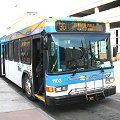- By Patty Poist
- News
 Print
Print  TCAT General Manager Joe Turcotte announced today that TCAT has broken ridership records in 2012 for the sixth consecutive year.
TCAT General Manager Joe Turcotte announced today that TCAT has broken ridership records in 2012 for the sixth consecutive year.TCAT reported nearly 4.13 million annual trips in 2012, a 4.7 percent increase from the nearly 3.95 million trips in 2011.
“We are fortunate to live in a community that whole‑heartedly embraces its public transit system,” Turcotte said. “We are also blessed with dedicated team of bus operators, maintenance crew and an administrative staff who all work together – day in and day out – to make sure our system is the best of its size in the country.”
To be sure, TCAT in 2011 was named as the top transit agency of its size (fewer than 4 million annual trips in the small‑size category) in North America by the American Public Transportation Association (APTA). Crossing the 4‑million threshold now places TCAT in APTA’s medium‑size category (4‑30 million annual passenger trips).
“This is amazing for a service area that has a relatively small population of just a little more than 100,000 people,” Turcotte said.
Annual ridership for 2012 for the country is still in the process of being compiled, but APTA’s third‑quarter report indicates that bus ridership was up nationally by 1.76 percent. “This indicates that TCAT’s uptick in ridership corresponds to national trends,” said Matt Yarrow, TCAT’s service analyst/grant research assistant, in a report examining TCAT’s ridership.
Though it is difficult to determine how much impact gas prices have on ridership numbers, they are clearly a factor, Yarrow said. “As the cost of driving to work and other destinations increases, the bus becomes a more attractive option,” he said.
Also contributing to the 2012 ridership surge is the late-night service on routes serving Ithaca College and Cornell University, which show the largest percentage ridership increase.
TCAT began a partnership with Ithaca College in the fall of 2011, enabling Route 11/90 passengers more frequency to travel between campus, downtown or Cornell University at night and in the early‑morning hours on Thursdays, Fridays and Saturdays.
TCAT Service Development Manager Doug Swarts, who worked with Ithaca College to develop the more frequent service, said ridership on those routes have more than doubled, far exceeding expectations.
“The success of this improved service just goes to show that there is latent demand for affordable transportation in our community and, when we provide attractive service, the riders come out of the woodwork,” Swarts said.
Yarrow said he was surprised that rural ridership remained unchanged from 2011 to 2012, even though TCAT in early 2012 raised fares for boardings originating in rural areas (Zone 2) from $1.50 to $2.50.
“Although some may have been deterred from riding TCAT due to the fare increase, overall the fare increase did not negatively affect ridership on rural routes nearly as much as might have been expected,” he said.
Despite all the good news with ridership numbers, Turcotte said TCAT’s biggest challenge continues in having a predictable and adequate funding source, particularly for TCAT’s pressing capital needs.
“Aging buses need to be replaced; we are outgrowing our TCAT facility; and our passengers are continually asking for better technologies to help them navigate the system,” Turcotte said. “Fortunately, and we can say with full confidence, any investment in TCAT is an investment in the entire community as our service is a critical component to local economic development.”
v9i3



